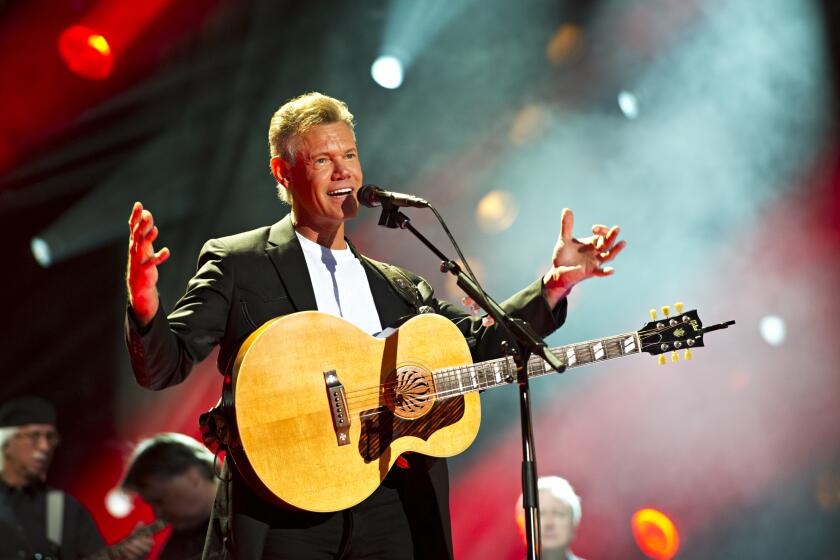The song in our hearts
BY JANUARY 1973, country music legend Waylon Jennings was facing ruin -- wracked by hepatitis, crippled by amphetamine addiction and emotionally awash in the wake of a third destroyed marriage. His friends urged him to hang up his guitar. Instead, he flew to New York and opened a six-day run at Max’s Kansas City.
“[W]e play country music,” Jennings told the crowd. “We hope you like it. If you do, I want you to tell everybody you know how much you like it. If you don’t like it, don’t say anything mean about it, because if you ever come to Nashville, we’ll kick your ass.”
As Amanda Petrusich suggests in “It Still Moves: Lost Songs, Lost Highways, and the Search for the Next American Music,” Jennings was canny enough to know that he needed a myth -- a fresh back story -- to save his career. He chose the archetypal Southern outlaw, armed with a bad attitude and a wide-brimmed hat. The ploy worked: Years later, he would remember the trip as a career-saving “triumph.”
America’s music history is filled with similar reinventions. Elvis Presley bumbled into Memphis’ Sun Records in 1953 and emerged as the first white man to adapt successfully the “sound of the black cultural experience” for “a largely segregated public.”
And Johnny Cash, who never served any real prison time, meticulously cultivated the “dark, bloodied-knuckles persona of the outlaw-convict.”
The alchemy of our national soundtrack, Petrusich writes, is the alchemy of myth, “subject to our environs, fashioned and chiseled and sanded into shapes. We have highways for arteries and clouds for brains and sticks for bones. The sounds we make are Americana.”
In 2007, Petrusich, a contributing editor at Paste magazine, spent months looping through rural America, searching for “the songs I love -- Americana music, craggy, tottering, uncontrollable country, blues, and folk -- to see where they started, and what they’ve since inspired.” The hunt began in Nashville, ground zero for Cash and Jennings, and expanded outward, in concentric circles across the country.
“It Still Moves” is an act of synthesis. Part travelogue, part history lesson on the rise of Americana music -- “infused with the vitality of the landscapes from which it has sprung” -- it’s heavily reliant on texts by Peter Guralnick, among others. Not much is new here, and that’s the point; Petrusich, a twentysomething Brooklynite, is excavating a musical mosaic completed before she was born.
Occasionally, the results are thrilling. At her best, Petrusich is both awe-struck and erudite, injecting the knotty history of Americana with a personable warmth. Her heroes become our own. But too often, “It Still Moves” disintegrates into a string of notable dates. Since we’re getting a lot of the material at a remove, the absence of voice here stings.
More egregiously, for a writer who traffics mostly in contemporary music, Petrusich seems curiously uninterested in the “Next American Music.” Missing, for example, are in-depth discussions of acts like Animal Collective or Devendra Banhart, which have -- in different ways -- reinvigorated Americana. Aiming for musical oracularism, Petrusich mostly ends up with mere nostalgia.
No such paucity of scope threatens Daniel J. Levitin’s masterful “The World in Six Songs: How the Musical Brain Created Human Nature.” Levitin, a research scientist at McGill University and the author of “This Is Your Brain on Music,” takes the entire history of song as his canvas: classical, jazz, even the murmuring of cavemen flush with the success of a big hunt.
How deeply has music shaped our consciousness? Deeply enough, Levitin writes, that we can see its effect on the evolution of our brains “over tens of thousands of years and across the six inhabited continents.” It is a “core element of our identity as a species.”
That’s a sweeping thesis, and to keep it manageable, Levitin divides the book into six sections: “Friendship,” “Joy,” “Comfort,” “Knowledge,” “Religion” and “Love.” Each is represented by a song -- “Joy,” for example, gets “Sometimes You Feel Like a Nut.”
Using both scientific data and conversations with a host of musicians -- including Paul Simon and Sting -- Levitin argues that our neurological development and the history of music are inextricably intertwined. Consider the simple nursery rhyme, discussed in the chapter “Knowledge.” We rarely think of these tunes as anything more than a calming conversation between parent and child. Yet they offer a “powerful mnemonic force for encoding knowledge.”
This encoding was used by tribal societies to transmit important information like the “locations of resources” and “perceptions of dangers.” Writes Levitin: “Making and listening to music feels good not because of anything intrinsic in the music. Rather, those of our ancestors who happened to feel good during musical activities are the ones who survived to pass on the gene that gave rise to these feelings.”
“The World in Six Songs” sometimes tacks too far toward the anecdotal. But it’s the anecdotes that make this book so eminently enjoyable: Levitin goes small in order to get at the infinitely complex. And like Petrusich, he lets his love for song bleed into his writing. “Music,” he writes, “is -- dare I say it -- magical.”
More to Read
The biggest entertainment stories
Get our big stories about Hollywood, film, television, music, arts, culture and more right in your inbox as soon as they publish.
You may occasionally receive promotional content from the Los Angeles Times.






